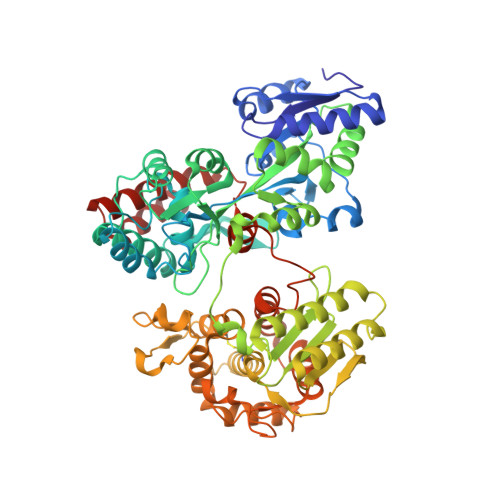Structure of an Engineered beta-Lactamase Maltose Binding Protein Fusion Protein: Insights into Heterotropic Allosteric Regulation.
Ke, W., Laurent, A.H., Armstrong, M.D., Chen, Y., Smith, W.E., Liang, J., Wright, C.M., Ostermeier, M., van den Akker, F.(2012) PLoS One 7: e39168-e39168
- PubMed: 22720063
- DOI: https://doi.org/10.1371/journal.pone.0039168
- Primary Citation of Related Structures:
4DXB, 4DXC - PubMed Abstract:
Engineering novel allostery into existing proteins is a challenging endeavor to obtain novel sensors, therapeutic proteins, or modulate metabolic and cellular processes. The RG13 protein achieves such allostery by inserting a circularly permuted TEM-1 β-lactamase gene into the maltose binding protein (MBP). RG13 is positively regulated by maltose yet is, serendipitously, inhibited by Zn(2+) at low µM concentration. To probe the structure and allostery of RG13, we crystallized RG13 in the presence of mM Zn(2+) concentration and determined its structure. The structure reveals that the MBP and TEM-1 domains are in close proximity connected via two linkers and a zinc ion bridging both domains. By bridging both TEM-1 and MBP, Zn(2+) acts to "twist tie" the linkers thereby partially dislodging a linker between the two domains from its original catalytically productive position in TEM-1. This linker 1 contains residues normally part of the TEM-1 active site including the critical β3 and β4 strands important for activity. Mutagenesis of residues comprising the crystallographically observed Zn(2+) site only slightly affected Zn(2+) inhibition 2- to 4-fold. Combined with previous mutagenesis results we therefore hypothesize the presence of two or more inter-domain mutually exclusive inhibitory Zn(2+) sites. Mutagenesis and molecular modeling of an intact TEM-1 domain near MBP within the RG13 framework indicated a close surface proximity of the two domains with maltose switching being critically dependent on MBP linker anchoring residues and linker length. Structural analysis indicated that the linker attachment sites on MBP are at a site that, upon maltose binding, harbors both the largest local Cα distance changes and displays surface curvature changes, from concave to relatively flat becoming thus less sterically intrusive. Maltose activation and zinc inhibition of RG13 are hypothesized to have opposite effects on productive relaxation of the TEM-1 β3 linker region via steric and/or linker juxtapositioning mechanisms.
Organizational Affiliation:
Departments of Biochemistry, Case Western Reserve University, Cleveland, Ohio, United States of America.















